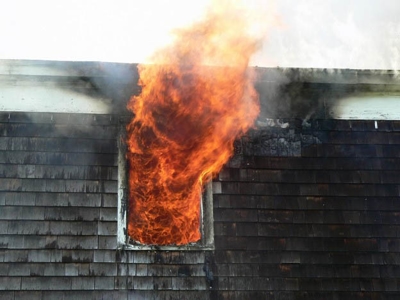
As if dealing with house fire and smoke damage wasn't enough, once the initial danger has passed, you also have to contend with the resulting soot that may have spread throughout your home. You'll quickly discover that soot is an eyesore that's very tough to clean, but you may not have considered the hidden dangers of soot. Learn more about the basic science of soot, its physical properties and the hazards poor clean-up can pose so you can fully protect your home and family in the aftermath of a fire.
WHAT IS SOOT?
The black residue that sticks around after a fire, a.k.a. soot, is the result of incomplete fossil fuel combustion. When coal, oil, wood or other fuels are burned, the residual material, comprised mostly of carbon, can travel through the air and settle into the surrounding environment. While soot-producing fuels are often burned for industrial uses, manufacturing and operating vehicles, you may also come across residential sources of soot, too. House fires and insufficient ventilation in the fireplace are some of the most common causes of soot within the home.
.jpg)
WHAT DOES SOOT LOOK AND SMELL LIKE?
Do you know how to identify soot in your own home? You can spot accumulated soot by looking for dark black residue accumulated fire damaged areas, but individual soot particles are nearly microscopic – even smaller than dust! Soot particles can turn up in areas far away from the original source of the fire and can even travel from room to room through your ventilation system. In addition to looking for black particles, you can rely on your nose to sniff out the soot. If you've recently experienced a fire or furnace or fireplace puffback and you can still smell smoky, ashy or just plain stinky odors, you may be detecting hints of soot.
IS SOOT HARMFUL?
Simply put, yes. During a common house fire, both natural and synthetic materials burn. The resulting soot particles can contain acids, chemicals, metals, dust and other hazardous materials. These toxic particles then stick to surrounding surfaces, like walls and ceilings, leaving you and your home exposed to the harmful effects.
ENVIRONMENTAL RISKS OF SOOT
When fossil fuels are burned for industrial purposes, the chemical compounds of soot are released into the environment and affect multiple aspects of our ecosystem. Soot contamination in your home acts similarly, impacting indoor air quality, in addition to leaving foul odors and stains behind.
HEALTH RISKS OF SOOT
If it goes untreated or improperly cleaned, tiny particles of soot can be inhaled deep into the lungs. These toxic particles can cause breathing issues, including aggravated asthma, bronchitis and more severe respiratory illnesses that can restrict your ability to carry out normal activities. To avoid health risks and restore your home to its former stain- and odor-free glory, focus on achieving complete, thorough and proper cleaning of all soot-affected areas.
[1].jpg)
SOOT CLEAN-UP
Because of its microscopic particle size, ability to travel through the air and tendency to stick to hard surfaces, soot contamination is very challenging to clean up. In fact, improper attempts at cleaning can cause the soot to spread and absorb, further damaging your home and belongings. While you can attempt to remove soot from your walls and ceilings on your own, you should always follow strict safety precautions and make sure you thoroughly clean the areas with proper procedures and great attention to detail. To ensure your safety and avoid permanent damage to your home and belongings, we recommend leaving soot cleanup to the professionals. Contact the experts at ServiceMaster Restore® to provide thorough soot and smoke odor removal services so you can enjoy your home and breathe easy again.
Getting rid of hidden soot might be difficult for others, but not for us. If you need fire damage support, you can learn more about our services or call 1-800-RESPOND today.
